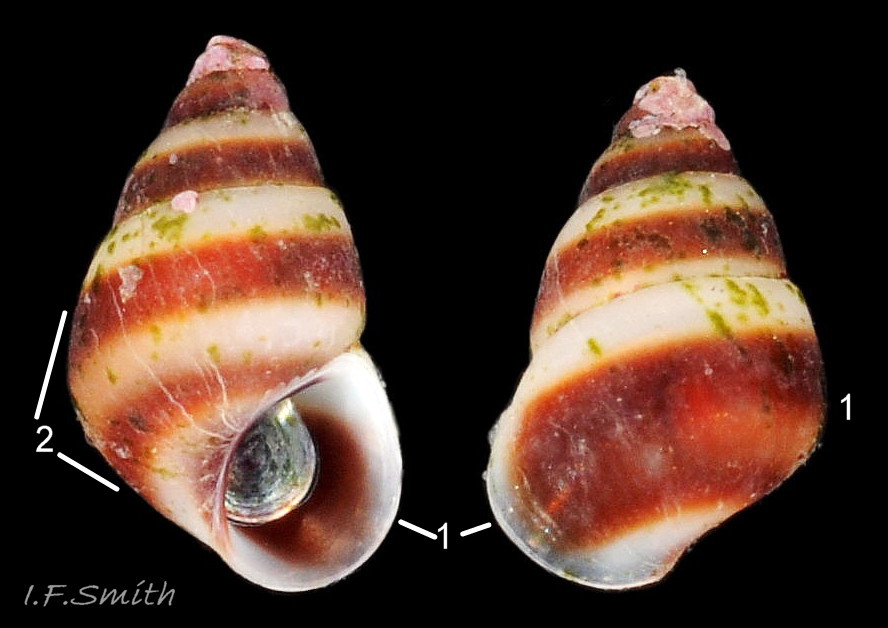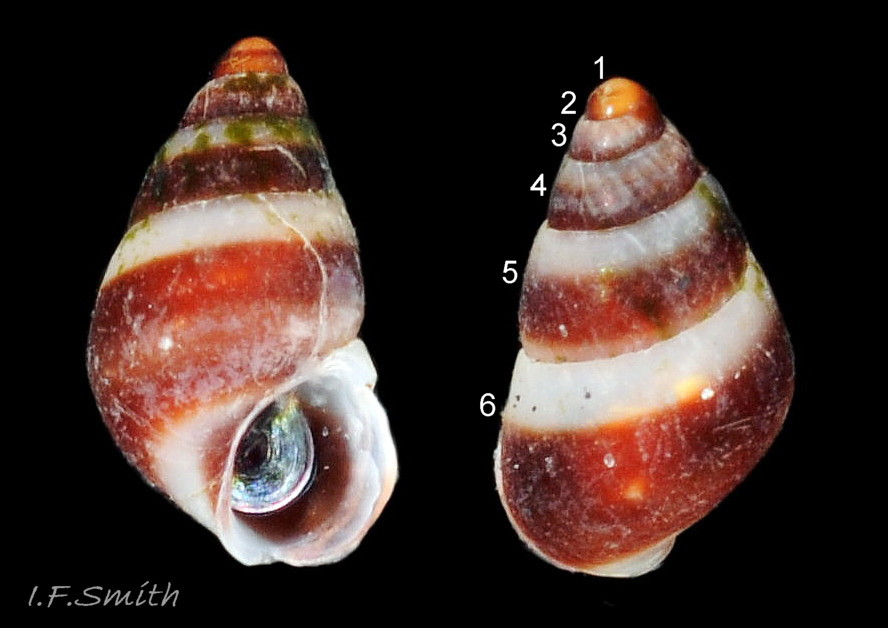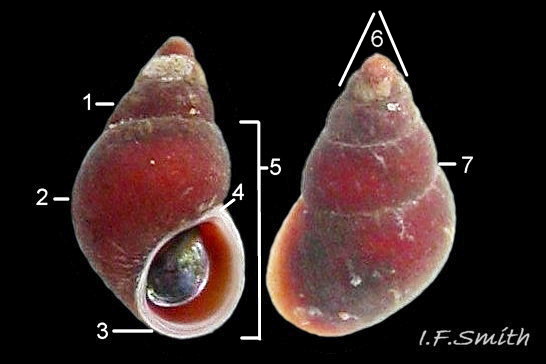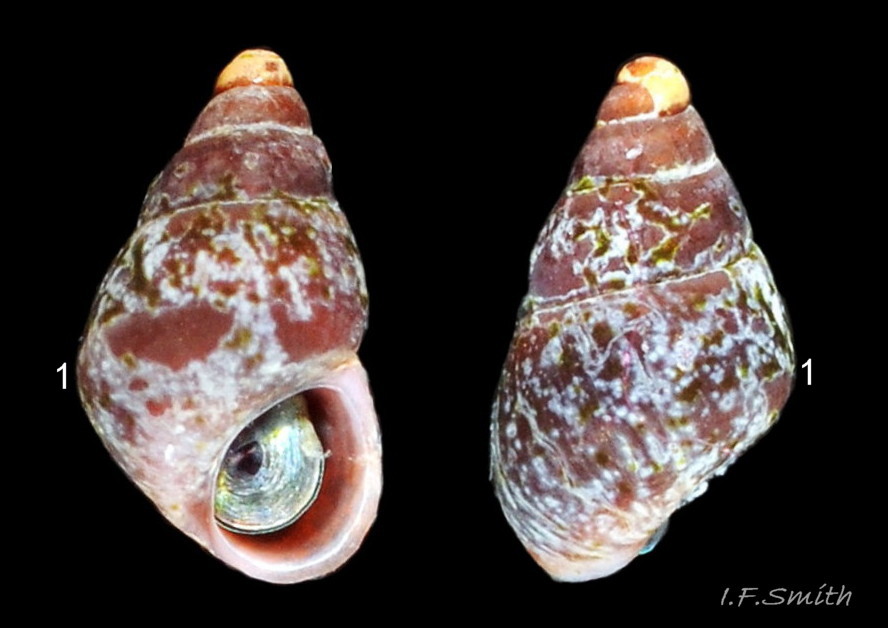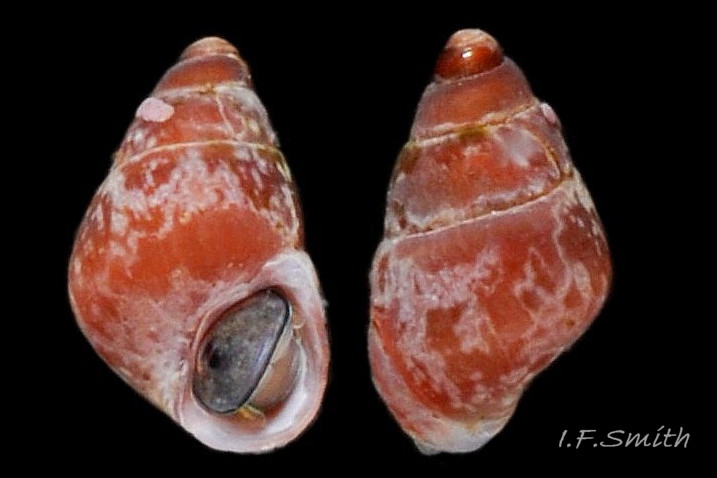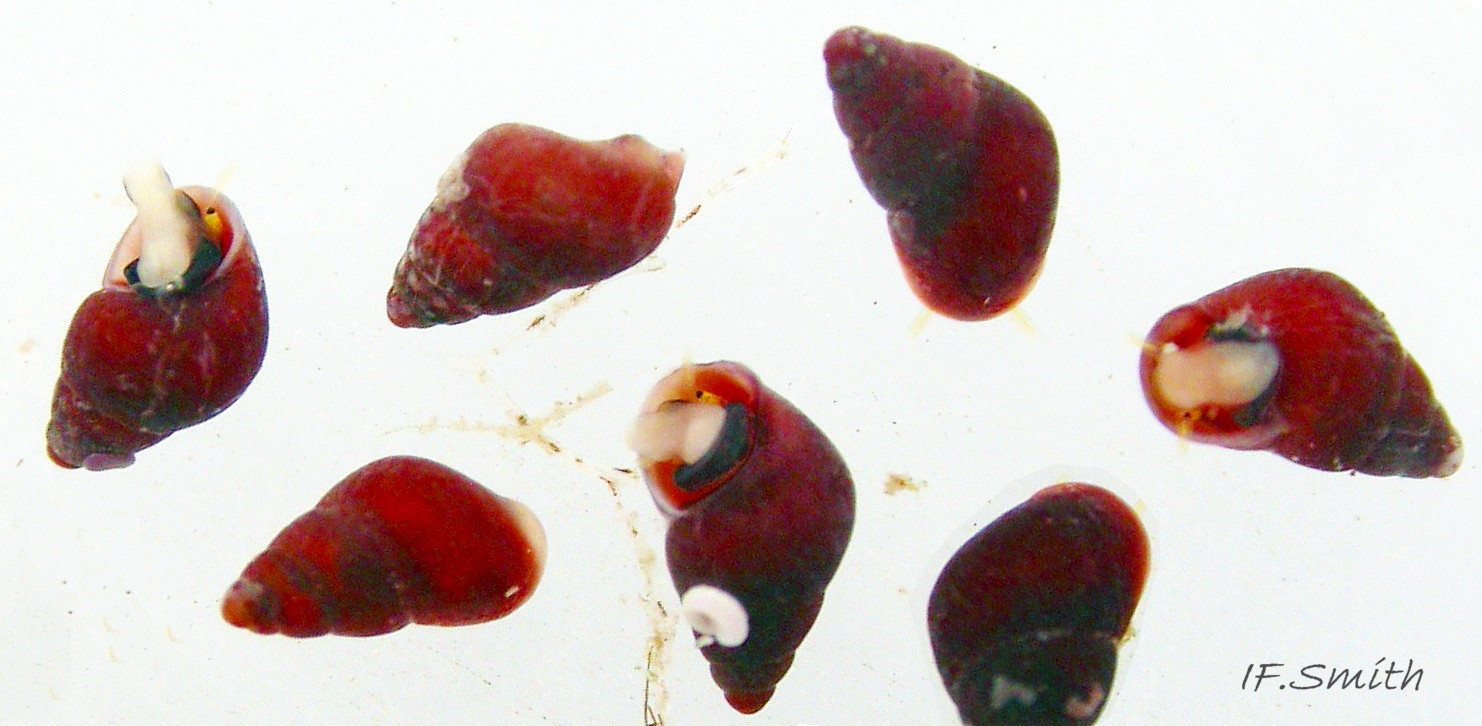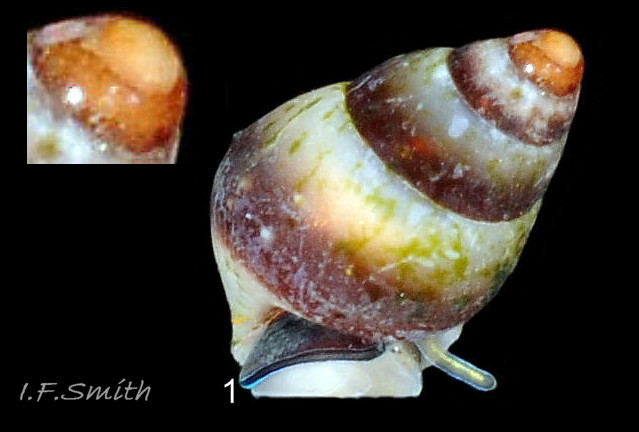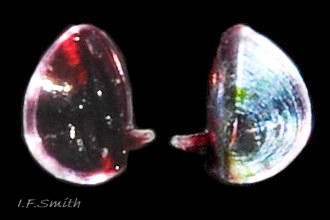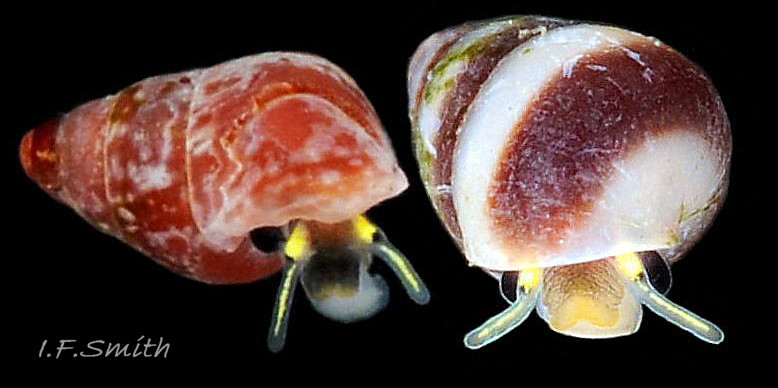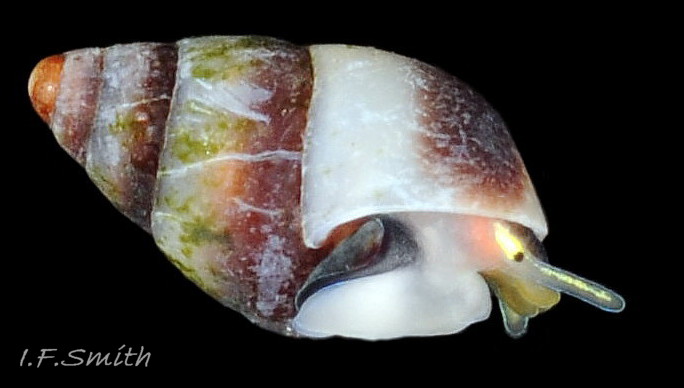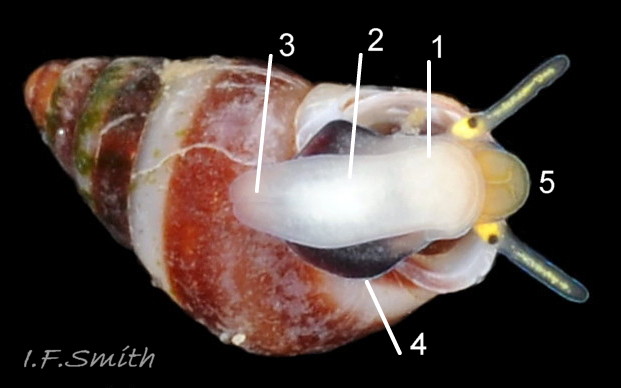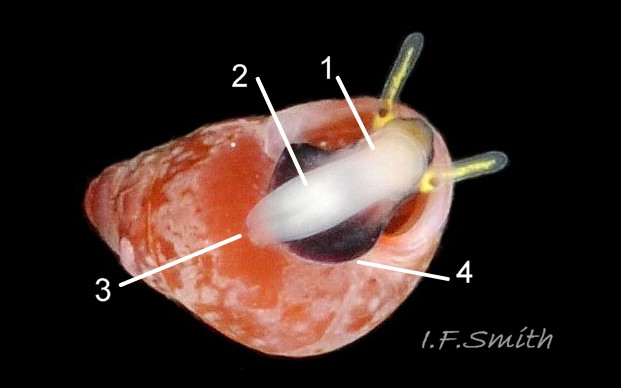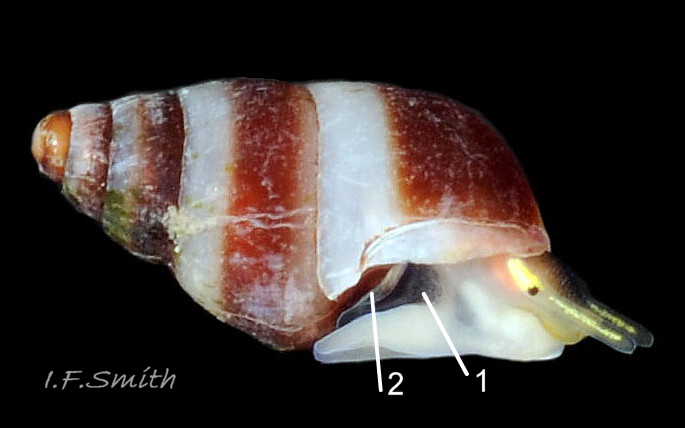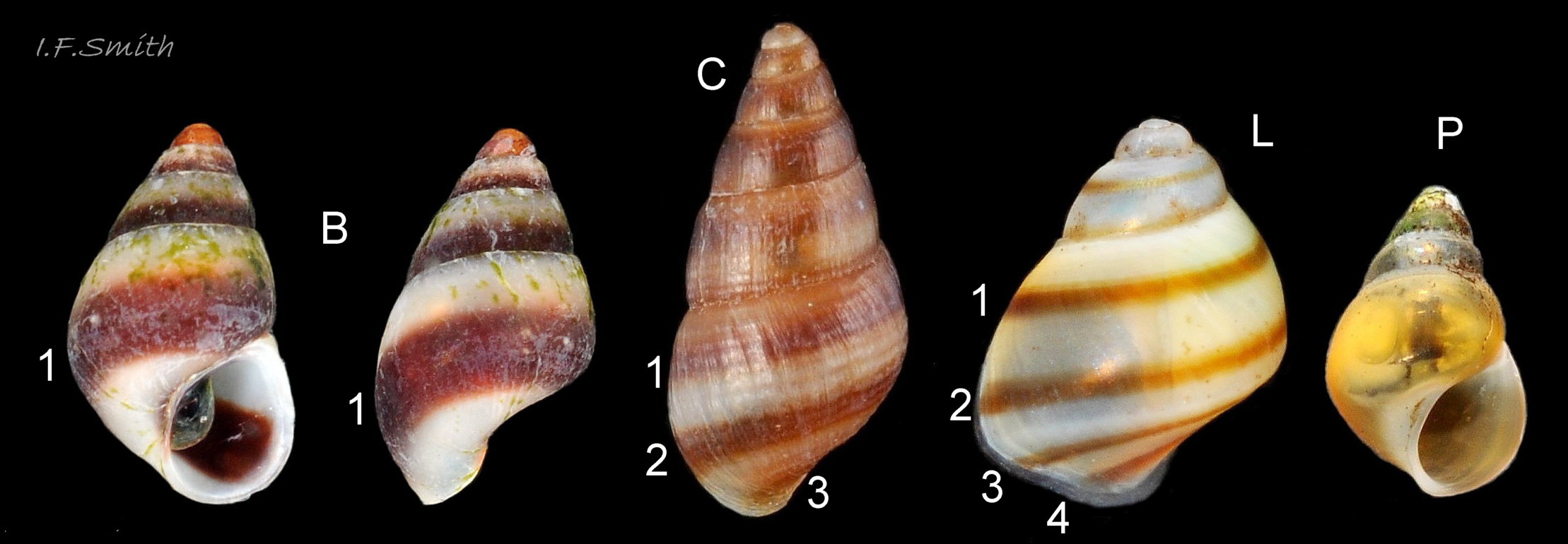Click image to enlarge with full caption. Main text below slider.
Barleeia unifasciata (Montagu, 1803)
Image links: 01Bu 02Bu 03Bu 04Bu 05Bu 06Bu 07Bu 08Bu 09Bu 10Bu 11 Bu 12Bu 13Bu 14Bu 15Bu 16Bu 17Bu
PDF available at: www.researchgate.net/publication/358147781_Barleeia_unifa…
Synonyms: Turbo unifasciatus Montagu, 1803; Rissoa rubra J. Adams, 1797 [in Forbes & Hanley]; Barleeia rubra (J. Adams, 1797); Barleeia rubra var. pallida Jeffreys, 1867;
Derivation of scientific name: Barleeia = named after G. Barlee (friend of G. Jeffreys). unifasciata = with a single band
Vernacular: Red spire shell (English); Bandhoren (Dutch).
GLOSSARY BELOW
Shell Description
The small shell seldom exceeds 3 mm height 01 Barleeia unifasciata . Above the periphery of the body-whorl, it is conical with an almost flat-sided profile. The body-whorl forms about 70% of the shell height; above it the spire has five whorls when fully grown 02 Barleeia unifasciata . The apical angle is about 45° 03 Barleeia unifasciata . At the apex there is globular protoconch of 1½ whorls 02 Barleeia unifasciata & 08 Barleeia unifasciata with microscopic, spiral grooves containing pits visible at X 180 magnification.
The whorls are slightly convex, almost flat, with shallow sutures. On some, the periphery of the body-whorl is slightly keeled 04 Barleeia unifasciata . The oval aperture on adults has a white peristome 03 Barleeia unifasciata , but no rib or labial varix . The adapical angle is about 90°. The base of the columellar lip is sometimes flared into a slight spout. There is no umbilicus, except on very young juveniles, but sometimes the columellar lip is a little everted over an umbilical groove. The exterior is smooth with no sculpture.
There are two colour forms:
a) Uniformly brownish/reddish varying from yellowish-brown or brick-red 05 Barleeia unifasciata to claret-red 03 Barleeia unifasciata or brown 06 Barleeia unifasciata . Hence the synonym B. rubra
b) White with a single broad, spiral, abapical, brownish band 02 Barleeia unifasciata which is widest on the body whorl as it is partly covered by subsequent whorls on the spire. Hence the specific epithet unifasciata. Occasionally the brown band may separate into two narrower bands 01 Barleeia unifasciata .
Erosion can alter the colour 04 Barleeia unifasciata and occasionally the shell is completely white. Locally, the banded or un-banded form may predominate 07 Barleeia unifasciata .
The periostracum is thin and inconspicuous. The strong, D-shaped, flexed operculum looks black on the live animal 08 Barleeia unifasciata . Its outer surface is convex and often reflects silvery with concentric growth lines around a large less-reflective excentric nucleus 04 Barleeia unifasciata . When removed from the body 09 Barleeia unifasciata , the concave, interior face is very dark crimson and glass-like, and has a strong medial rib which turns basally at right-angles towards the columella and projects as a pale tipped peg that embeds in the columellar muscle when live.
Body Description
Published descriptions of soft parts have been confused since Jeffreys (in Forbes and Hanley, 1850) described the soft parts of Peringia ulvae as those of Rissoa rubra (= B. unifasciata). Jeffreys, (1867) recognised his mistake, but the error seems to have been perpetuated by subsequent authors such as Fretter & Graham (1978).
Dorsally the head is translucent, pale-yellowish overlaid by pigment which may be a fine spray of brown, but is frequently densely black 10 Barleeia unifasciata except on the tip of the snout. Laterally and ventrally there is very little or no dark pigment; the bifid snout is yellow, and behind the tentacles the translucent white flesh reveals the reddish buccal mass 11 Barleeia unifasciata . Ventrally, the tip of the snout has T-shaped mouth slits 12 Barleeia unifasciata . The short, smooth, un-tapered, cylindrical cephalic tentacles are translucent whitish with a substantial, interior, yellow line 10 Barleeia unifasciata . The prominent swollen base of each tentacle is yellow with a large black eye. The small foot is white except for a large blackish area to which the operculum is attached 14 Barleeia unifasciata . The operculum covers 75% of the posterior part of the extended foot and protrudes far beyond its sides 12 Barleeia unifasciata & 13 Barleeia unifasciata . The sole has almost parallel sides, a bilaminate, bluntly-rounded anterior and a slightly tapered, rounded posterior. The posterior pedal gland is visible through the middle of the sole as a large opaque area with a groove from it to the posterior of the foot 12 Barleeia unifasciata . The anterior pedal gland, opening through the bilaminate anterior, is also visible as an opaque area.
Key identification features
Barleeia unifasciata
1) Maximum shell height 3 mm. Spire-whorls of banded forms have a broad whitish adapical band, and a broad brownish-red abapical band 02 Barleeia unifasciata .
2) Operculum looks black on live animal 08 Barleeia unifasciata ; outer face convex often silvery with concentric growth rings 04 Barleeia unifasciata ; inner face (when removed) dark ruby-red and concave with medial rib that turns at right-angles and projects as a pale tipped peg 09 Barleeia unifasciata .
3) Head and snout pale-yellowish usually overlaid dorsally with black or brown pigment 10 Barleeia unifasciata .
4) Cephalic tentacles translucent white with swollen yellow base and substantial longitudinal yellow line 10 Barleeia unifasciata .
Similar species
Cingula trifasciata (J. Adams, 1800)
1) Maximum shell height usually 4 mm.
Spire-whorls of banded forms have broad whitish abapical band, and broad brownish-red adapical band i.e. colour positions reverse of B. unifasciata. There is often very thin brown-red band along the abapical suture. Body-whorl has three brownish-red bands). 15 Barleeia unifasciata
2) Operculum a horn-coloured, oval, excentric spiral.
3) Head and snout translucent white showing some internal yellow and red features. 16 Barleeia unifasciata
4) Cephalic tentacles translucent white 16 Barleeia unifasciata
Lacuna vincta (Montagu, 1803)
1) Maximum shell height usually 10 mm, but only juveniles present in summer (1-3 mm July in N. Wales) and shell relatively much wider than B. unifasciata. Spire-whorls of banded forms have diverse arrangements of bands, rarely arranged as on B. unifasciata 15 Barleeia unifasciata .
2) Operculum transparent pale horn-coloured ovoid; rapidly expanding spiral.
3) Head and snout translucent white or yellow, may be blotched aquamarine, showing some internal pink features 16 Barleeia unifasciata .
4) Cephalic tentacles translucent whitish 16 Barleeia unifasciata .
Peringia ulvae (Pennant, 1777)
1) Maximum shell height usually 6 mm, exceptionally 10 mm.
2.5 mm-high juvenile 15 Barleeia unifasciata might be mistaken for un-banded Barleeia unifasciata, but more yellowish and thinner shelled.
2) Operculum tear-shaped, horn-coloured, spiral. Translucent, appearing partially black on live specimen as shows dark body
3) Head and snout have variable amounts of black 16 Barleeia unifasciata .
4) Long, tapering, translucent white, cephalic tentacles with opaque white basal eye-patch and opaque white longitudinal line with transverse black bar near tip of tentacle 16 Barleeia unifasciata .
Habits and ecology
B. unifasciata lives on small red algae, such as Chondrus and Gelidium, growing as a turf on sheltered rocky shores near LWS, especially in pools 17 Barleeia unifasciata . In North-west Spain it is common in the Gelidium zone on the middle shore. In Britain it is often in company with Rissoa parva and, in Spain, with Bittium reticulatum. It feeds on diatoms and organic detritus entrapped by algal fronds. The density is lowest when the algal turf is at a minimum (December – May in North-west Spain).
Locomotion. The anterior pedal gland, opening in the bilaminate anterior of the foot, and many cells in the epithelium of the foot produce mucus to aid locomotion. The posterior pedal gland produces a secretion that is formed into threads by a groove in the metapodium and is hardened by contact with seawater. The threads are used for anchorage and as vertical movement supports 12 Barleeia unifasciata .
Breeds March – August at Plymouth, England, but all year with four overlapping cohorts per annum and main activity in June-November in North-west Spain. Semelparous reproduction is reported in Spain, but in Bantry Bay, Ireland, some females are reported to breed in the first and second years of life (only about 15% live into a second year, maximum age 2 years). The Bantry Bay population breeds all year, with the main period June – October and the peak in August (Southgate, 1982). Internal fertilization is with a long penis. Spawn is individual, colourless, thick-walled, spherical egg capsules, diameter 0.5 mm, containing a single, large (diameter 0.3 mm), colourless ovum embedded in albumen. Each capsule is attached to weed, such as Corallina, by a very narrow attachment. The veliger stage is passed within the capsule, feeding on albumen. A suture on the capsule ruptures and the young emerges as a crawling snail with a shell of 1½ whorls, 0.45mm high.
Distribution and status
Canary Isles and Mediterranean to Scotland, not North Sea or Baltic, GBIF map www.gbif.org/species/2301011 . Commonest in the south; up to 1780/m² recorded on Gelidium in north-west Spain. Found on west coasts of Britain and Ireland; most frequent in SW England and SW Wales, absent from North Sea and north-east Irish Sea. U.K. map NBN species.nbnatlas.org/species/NBNSYS0000174093
References and links
Estran 22. Faune et flore de la zone de balancement des marées en Côtes d’Armor (Web site).
nature22.com/estran22/mollusques/gasteropodes/gasteropode…
Fernandez, E., Anadon, R. & Fernandez, C. 1988. Life histories and growth of the gastropods Bittium reticulatum and Barleeia unifasciata inhabiting the seaweed Gelidium latifolium. J. Moll. Stud. 54, 119-129. www.unioviedo.es/ranadon/Ricardo_Anadon/Trabajos/Bittium%…
Forbes, E. & Hanley S. 1850. A history of the British mollusca and their shells. vol. 3. London, van Voorst. (As Rissoa rubra.) archive.org/stream/historyofbritish03forbe#page/120/mode/2up Contains description of the tentacles, by Jeffreys who admitted that he mistakenly described Peringia ulvae.
Fretter, V. and Graham, A. 1962. British prosobranch molluscs. London, Ray Society. (As Barleeia rubra).
Fretter, V. & Graham, A. 1978. The prosobranch molluscs of Britain and Denmark. Part 4 marine Rissoacea, J. Moll. Stud., suppl. 6, 153-241.
Graham, A. 1988. Prosobranch and pyramidellid gastropods. London, Linnean Society of London.
Jeffreys, J.G. 1867. British conchology. vol. 4. London, van Voorst. (As Barleeia rubra ;
archive.org/stream/britishconcholog04jeffr#page/56/mode/2up
Ponder, W.F. 1983. Review of the genera of the Barleeidae (Mollusca: Gastropoda; Rissoacea) Records of the Australian Museum 35: 231 – 281. Link to pdf at:
australianmuseum.net.au/journal/ponder-1983-rec-aust-mus-…
Southgate, T. 1982. The biology of Barleeia unifasciata (Gastropoda:Prosobranchia) in red algal turfs in S.W. Ireland. J.M.B.A. 62: 461 – 468. Abstract at journals.cambridge.org/action/displayAbstract?fromPage=on…
Current taxonomy: World Register of Marine Species (WoRMS)
www.marinespecies.org/aphia.php?p=taxdetails&id=138843
Glossary
abapical = away from the apex of the shell.
adapical = towards the apex of the shell.
aperture = mouth of gastropod shell; outlet for head and foot.
apical = at the apex.
bifid = divided into two parts by a cleft.
buccal mass = anterior of digestive system containing odontophore that supports anterior of radula.
cephalic = (adj.) of or on the head.
chitin = semitransparent flexible horny protein.
chitinous = (adj.) resembling chitin.
columella = solid or hollow axial “little column” around which gastropod shell spirals; hidden inside shell, except on final whorl next to lower part of inner lip of aperture.
columellar = (adj.) of or near central axis of spiral gastropod.
columellar lip = lower (abapical) part of inner lip of aperture.
conchiolin = horny flexible protein that forms the operculum of most marine gastropods, and a matrix for the deposition of calcium carbonate to create a mollusc’s shell.
concolorous = the same colour as.
distal = away from centre of body or point of attachment.
epithelium = tissue forming outer layer of body surface.
ELWS = extreme low water spring tide (usually near March and September equinoxes).
excentric = (of nucleus on operculum) not placed centrally.
height = (of gastropod shell): distance from apex of spire to base of aperture.
labial varix = especially strong or broad costa (rib) along edge of outer lip of aperture.
LWS = low water spring tide, two periods of a few days each month when tide falls lowest.
metapodium = hind part of the foot.
metapodial = (adj.) of the hind part of the foot.
opercular = (adj.) of the operculum.
operculum = plate of horny conchiolin, rarely calcareous, used to close shell aperture.
pedal = (adj.) of the foot.
periostracum = thin horny layer of chitinous material often coating shells.
peristome = (a.k.a. peritreme) rim around the shell-aperture.
plankton = animals and plants that drift in pelagic zone (main body of water).
protoconch = apical whorls produced during embryonic and larval stages of gastropod; often different in form from other whorls.
radula = ribbon of chitinous teeth extruded on a tongue-like structure (odontophore) to rasp food.
semelparous = (adj.) having single reproductive episode followed by death.
sublittoral = below level of low water spring tide
subterminal = a short distance from the end.
suture = groove or line where whorls adjoin.
umbilicus = cavity up axis of some gastropods, open as a hole or chink on base of shell, often sealed over.
varix = (pl. varices). Very strong or broad costa (rib) along edge of aperture (labial varix), or at previous position of labial varix during growth.
veliger = shelled larva of marine gastropod or bivalve mollusc which swims by beating cilia of a velum (bilobed flap).
velum = bilobed flap on veliger larva, with beating cilia for swimming.
